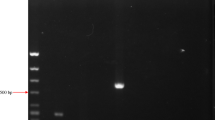Abstract
Sulphamethoxazole/trimethoprim (SMX/T) is an antimicrobial agent that has been used for decades against both Gram-positive and Gram-negative bacteria as well as protozoa. It is particularly used as prophylaxis against Pneumocystis carinii pneumonia (PCP) in patients with acquired immune-deficiency syndrome (AIDS). Its use in dogs with associated adverse reactions has necessitated an experimental study that may enhance clinical management of the toxicities. The study aimed to determine the effects of prolonged treatment with high doses of sulphamethoxazole/trimethoprim on the haematological profile of dogs. Dogs were given SMX/T at 30, 60 and 120 mg/kg body weight at 12-h intervals for 21 days. The packed cell volume (PCV), haemoglobin concentration (HbC), red blood cell (RBC) count and total and differential white blood cell (WBC) counts were performed using standard techniques. Data generated was analysed by one-way analysis of variance (ANOVA). Alopecia, epistaxis and skin eruptions were seen at the dose of 120 mg/kg. There were also dose-dependent decreases in the PCV and RBC count. HbC was significantly (p < 0.05) lower than the control only at the dose of 120 mg/kg. Total WBC count was significantly (p < 0.05) lower than the control only on day 7 of treatment at 30, 60 and 120 mg/kg. Beyond day 7, the white cell response, total and differential WBC counts, were fluctuating with significant depression at the dose of 120 mg/kg. Increase in dose and prolonged use of SMX/T in the dogs decreased the haematological parameters and increased the occurrence of toxic reactions and may outweigh the benefits of treatment with the drug in recommended cases.
Similar content being viewed by others
References
Anyogu DC, Shoyinka VSO, Ihedioha JI (2017) Effects of prolonged treatment with co-trimoxazole on the thyroid gland, liver, and epididymal sperm reserve in dogs. Clin Med Insights Pathol 10:1–7. https://doi.org/10.1177/1179555717742881
Brown MJ (1982) Adverse reactions to sulfaquinoxaline in coyote pups. J Am Vet Med Assoc 181(11):1419–1420
Cribb AE (1989) Idiosyncratic reactions to sulfonamides in dogs. J Am Vet Med Assoc 195(11):1615
Cribb AE, Spielberg SP (1990) An in vitro investigation of predisposition to sulphonamide idiosyncratic toxicity in dogs. Vet Res Commun 14:241–252
Eliopoulos GM, Huovinen P (2001) Resistance to trimethoprim-sulfamethoxazole. Clin Infect Dis 32(11):1608–1614
Fox LE, Ford S, Alleman AR, Harvey JW, Homer BL (1993) Aplastic anaemia associated with prolonged high-dose trimethoprim-sulfadiazine administration in two dogs. Vet Clin Pathol 22(3):89–92
Higgins T, Beutler E, Doumas BT (2008) Measurement of haemoglobin in blood. In: Burtis CA, Ashwood ER, Bruns DE (eds) Tietz fundamentals of clinical chemistry, 6th edn. Saunders Elsevier, Missouri, pp 524–525
Kahn CM (2010) The Merck veterinary manual, 10th edn. Merck &Co., Whitehouse Station, U.S.A., pp 2283–2289
Muller GH, Kirk RW, Scott DW (1989) Small animal dermatology, 4th edn. WB Saunders Co, Philadelphia, pp 175–178
Neer TM, Savant RL (1992) Hypoprothrombinemia secondary to administration of sulfaquinoxaline to dogs in a kennel setting. J Am Vet Med Assoc 200(9):1344–1345
Osweiler GD, Green RA (1978) Canine hypoprothrombinemia resulting from sulfaquinoxaline administration. Vet Hum Toxicol 20(3):190–192
Perreten V, Boerlin P (2003) A new sulphonamide resistance gene (Sul3) in Escherichia coli is widespread in the pig population of Switzerland. Antimicrob Agents Chemother 47(3):1169–1172
Prescott JF, Baggott JD (1993) Antimicrobial therapy in veterinary medicine, 2nd edn. Iowa State University Press, Ames, IA, pp 119–126
Preusch PC, Hazelett SE, Lemasters KK (1989) Sulfaquinoxaline inhibition of vitamin K epoxaide and quinone reductase. Arch Biochem Biophys 269(1):18–24
Roder JD (2004) Sulfonamides. In: Plumlee KH (ed) Clinical veterinary toxicology. Mosby, Inc. St Louis, Missouri, pp 293–294
Skold O (2001) Resistance to trimethoprim & sulfonamides. Vet Res 32(3–4):261–273
Smith CL, Powell KR (2000) Review of the sulfonamides and trimethoprim. Pediatr Rev 21(11):368–371
Thrall MA, Weiser MG (2002) Hematology. In: Hendrix CM (ed) Laboratory procedures for veterinary technicians, 4th edn. Mosby, Missouri, pp 29–74
Torres SMF, McKeever PJ, Johnston SD (1996) Hypothyroidism in a dog associated with trimethoprim-sulphadiazine therapy. Vet Dermatol 7:105–108
Weiss DJ, Klausner JS (1990) Drug-associated aplastic anemia in dogs: eight cases (1984–1988). J Am Vet Med Assoc 196(3):472–475
Wilcke JR (1988) Therapeutic application of sulfadiazine/trimethoprim in dogs and cats: a review. Comp Anim Pract 2(9):3–8
Acknowledgements
The authors are grateful to Professor R. C. Ezeokonkwo and Professor D. N. Onah for approving the use of the dog kennel.
Funding
Authors received no grants for the research and/or publication of the manuscript.
Author information
Authors and Affiliations
Corresponding author
Ethics declarations
Conflict of interest
The authors declare that they have no conflict of interest.
Ethical approval
The study strictly adhered to the institutional guidelines on research involving animals. Approval was obtained from the Experimental Animal Ethics Committee of the Faculty of Veterinary Medicine, University of Nigeria, Nsukka PG/11/60133.
Rights and permissions
About this article
Cite this article
Anyogu, D.C., Shoyinka, S.V.O. & Ihedioha, J.I. Haematological changes in dogs with prolonged administration of high doses of sulphamethoxazole/trimethoprim. Comp Clin Pathol 27, 1001–1005 (2018). https://doi.org/10.1007/s00580-018-2693-6
Received:
Accepted:
Published:
Issue Date:
DOI: https://doi.org/10.1007/s00580-018-2693-6




